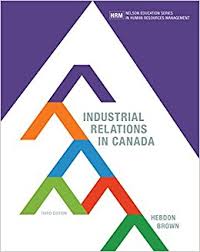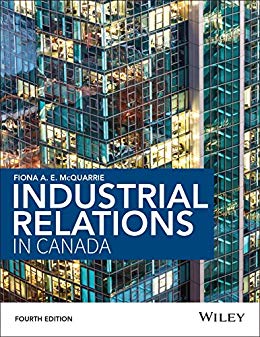Description
Test Bank For Industrial Relations In Canada 3rd Edition By Hebdon Brown
|
1. The new contract for the United Food and Commercial Workers Canada and Floralia Growers of Abbotsford provides rights for seasonal migrant workers to return to Canada. a. True b. False ANSWER: True |
|
2. A major feature of Roosevelt’s New Deal was the Wagner Act. a. True b. False ANSWER: True |
|
3. Under the court ruling of the Snider case the distinctive Canadian system of shared jurisdiction was declared illegal. a. True b. False ANSWER: False |
|
4. Certification is the process of gaining recognition under the appropriate government. a. True b. False ANSWER: False |
|
5. 5. A tripartite board has three stakeholders: employees, unions, and management. a. True b. False ANSWER: False |
|
6. Labour boards frequently determine charges of bad faith bargaining by either labour or management. a. True b. False ANSWER: False |
|
7. An unfair labour practice is an alleged violation of a Labour Relations Act. a. True b. False ANSWER: True |
|
8. A union has the duty not to discriminate or act in an arbitrary manner. a. True b. False ANSWER: True |
|
9. Employer structure is a criterion for determining an unfair labour practice. a. True b. False ANSWER: False |
|
10. Conciliation is a process in which a neutral third party forces labour and management to settle their dispute. a. True b. False ANSWER: False |
|
11. In some provinces, employers may force a last-offer vote during a strike. a. True b. False ANSWER: True |
|
12. In Canada strikes are illegal during the term of the collective agreement. a. True b. False ANSWER: True |
|
13. In their early decisions, the Supreme Court found that freedom of association included the right to strike. a. True b. False ANSWER: False |
|
14. On January 30, 2015, the Supreme Court constitutionalized the right to strike in Canada. a. True b. False ANSWER: True |
|
15. The Supreme Court of Canada has ruled that Walmart did not violate Quebec’s labour code when it closed a store in Jonquiere, Quebec after workers tried to unionize it. a. True b. False ANSWER: False |
|
16. Globalization of trade and the increased mobility of capital have created pressure for new international labour market rules. a. True b. False ANSWER: True |
|
17. With which union did The United Food and Commercial Workers Canada reach an agreement? a. Unifor b. Floralia Growers of Abbotsford c. Agricultural Workers of Canada of Canada d. Dairy Farmers Union ANSWER: b |
|
18. What was the Wagner Act intended to do? a. replace industrial unionism b. protect the union right to organize and strike c. protect employee rights d. establish international labour standards ANSWER: b |
|
19. What phenomenon resulted from scientific management and mass production? a. greater labour–management cooperation b. rise of craft unionism c. rise of industrial unionism d. stricter labour legislation ANSWER: c |
|
20. Which of the following was a result of the Wagner Act? a. Great Depression worsened b. scientific management went into decline c. legitimizing industrial unionization without violence d. union density stabilized ANSWER: c |
|
21. Why was the Snider decision important? a. It protected the employer right to manage. b. It determined that labour relations fell under federal jurisdiction. c. It determined that labour matters fell under provincial jurisdiction. d. It provided for conciliation before a strike could take place. ANSWER: c |
|
22. The Snider case resulted in a special system of law in Canada. What is this system called? a. shared jurisdiction b. scientific management c. common law d. dispute investigation ANSWER: a |
|
23. Why was P.C. 1003 introduced in Canada nine years after the Wagner Act? a. The Canadian parliamentary political system is slower than the American one. b. World War II and employer resistance delayed its implementation. c. A strong labour movement made change unnecessary. d. It was met with union opposition. ANSWER: b |
|
24. Which statement best describes certification procedures in Canada? a. All provinces require unions to win a vote of the employees. b. Management can have a say in selecting the union. c. Certification may occur without a vote in some provinces. d. Employee votes are not legally binding. ANSWER: c |
|
25. Why was the principle of exclusivity important in developing labour law? a. It defined bargaining units. b. It reduced conflict between unions. c. It limited management rights. d. It defined the bargaining unit ANSWER: b |
|
26. Why are labour boards an important alternative to courts? a. Courts are never neutral. b. Lawyers are not present at board hearings. c. Tripartite stakeholders do not agree. d. Courts do not specialize in labour law. ANSWER: d |
|
27. Under what circumstances can a labour board certify a union without an employee vote? a. if a firm has been found guilty of an unfair labour practice which hindered the vote b. if 40% of employees signed a union card c. if there is no application for certification d. if a community of interest exists ANSWER: a |
|
28. Why are Canadian labour boards tripartite in nature? a. to match the three levels of jurisdiction in Canada b. to represent three competing stakeholder perspectives c. to prevent a tie d. to allow boards to hear three kinds of cases ANSWER: b |





Be the first to review “Test Bank For Industrial Relations In Canada 3rd Edition By Hebdon Brown”